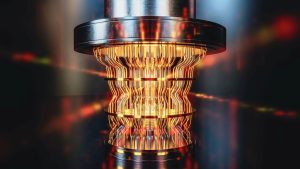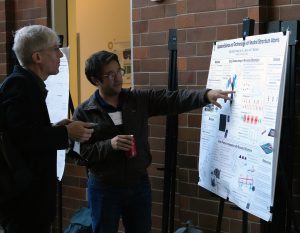Technological changes are coming sooner rather than later, and in the near future, according to the quantum technology education organization called Qureca, society will begin to see the effects of the quantum revolution. Their website states:
“In simple terms, quantum computing harnesses the strange and powerful properties of quantum mechanics to solve problems currently beyond the reach of classical computers. It’s like having a supercharged version of a computer that can explore many possible solutions to a problem simultaneously rather than one at a time.”
The topic of quantum computing took center stage at a recent UC Irvine CALIT2 workshop. On November 14, an audience-packed auditorium heard presentations from quantum information and computing experts.
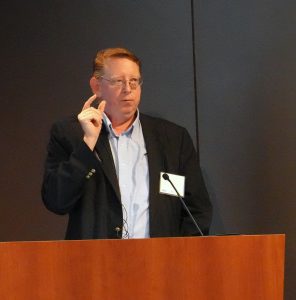
Peter Burke, UCI electrical engineering and computer science professor, opened the morning plenary session with an overview.
Peter Burke, UCI electrical engineering and computer science professor, opened the morning plenary session with an overview. He started with a timeline dating back to 1900 when Max Planck presented a formula that gave birth to quantum theory. After the history lesson, Burke explained the difference between binary (traditional) computers and quantum computers.
“The key difference between quantum computing and binary computing is that quantum computers use qubits,’ which can exist in a superposition of states with both 0 and 1 at the same time, while binary computers use ‘bits’ that can only be either 0 or 1,” said Burke. “This enables quantum computers to perform calculations on multiple possibilities simultaneously, making them potentially much faster for certain complex problems.”
In his classroom, Burke takes advantage of an IBM quantum platform that offers free access to quantum computing resources for students. The platform provides access to systems, documentation and learning resources, including 10 minutes of free execution time per month per each student enrolled in his class.
“I know that doesn’t sound like much, but since quantum computers are so powerful you can get a lot done in 10 minutes,” Burke said with a grin, eliciting laughter from the workshop attendees.
He emphasized that the emerging quantum systems market will require having a highly trained and skilled workforce, so it is important to introduce quantum concepts to engineering and computer science students at the undergraduate level.
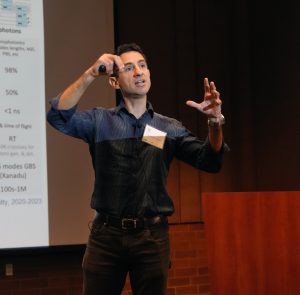
Julio Barreiro, UC San Diego assistant professor of physics, encourages students to solve quantum computing challenges with different approaches.
In his UC San Diego lab, Julio Barreiro, assistant professor of physics, encourages students to solve quantum computing challenges with different approaches.
“I motivate them to think outside the box,” Barreiro said. “I want them to embrace different approaches to quantum materials and devices in order to make great advances in the field.”
A relatively new research group at UCSD, the Barreiro team is working in the field of atomic, molecular and optical physics (AMO) and, in particular, ultracold atomic gases.
“We have built two ultracold strontium apparatuses with the long-term goals of building a fermionic quantum computer and atomtronic devices over nanophotonic circuits,” explained Barreiro.
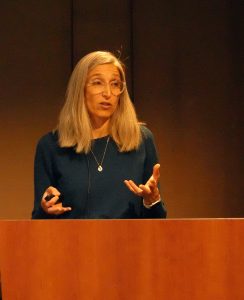
Sandy Irani, UCI computer science professor, told the audience that one of the central goals of her research is to understand quantum systems from the standpoint of computational complexity.
The third presenter, Sandy Irani, UCI computer science professor, told the audience that one of the central goals of her research is to understand quantum systems from the standpoint of computational complexity. She explained that physicists have been using computers for decades to understand various aspects of quantum systems, but these methods are typically heuristic and achieve success on only limited classes of systems.
“I study the properties of quantum systems and seek to understand which systems have inherent computational difficulty and which systems can be simulated efficiently on a classical or quantum computer,” Irani said.
Irani is one of 27 scientists in the UCI Eddleman Quantum Institute who represent a range of disciplines including chemistry, mathematics, physics and astronomy, computer science and electrical engineering. The Institute’s goal is to stimulate the discovery of new quantum science phenomena by developing collaborations between investigators in a broad range of scientific endeavors and to motivate future generations to study quantum science through educational and outreach activities.
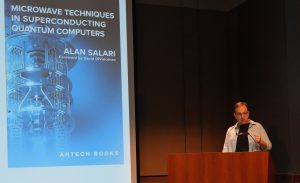
Alan Salari is an experimental quantum physicist and microwave engineer who earlier this year published his newest book, Microwave Techniques in Superconducting Quantum Computers.
The final morning session presenter, Alan Salari, is an experimental quantum physicist and microwave engineer at Quaxys LLC. A portion of his talk focused on SQUID transmon qubit, which is a type of qubit that uses a superconducting quantum interference device (SQUID) to tune the qubit’s operating characteristics.
“A SQUID transmon qubit is a modification of the fixed-frequency transmon qubit. It replaces the single Josephson junction of the fixed-frequency transmon with a SQUID loop made of two Josephson junctions in parallel,” Salari explained.
He told the audience that the benefit of SQUID transmon qubits is that they can help reduce errors in gates and improve the scalability of superconducting qubit devices.
Salari is also a prolific author and earlier this year published his newest book, Microwave Techniques in Superconducting Quantum Computers. The book is dedicated to microwave hardware for quantum computing, introducing microwave and quantum engineers to essential practical techniques and theoretical foundations crucial for operating and implementing hardware in superconducting quantum processors.
After a break for lunch, the afternoon workshop featured four brainstorming sessions. Each session had a series of rapid-fire presentations organized by a faculty host. The sessions were designed to convey key ideas and inspire new thinking. The four topics and hosts were State-of-the-Art Facility for Quantum Research, Shane Cybart, associate professor, UC Riverside; Quantum Computing Infrastructure Needs for Research and Education, Professor Harry Tom, UC Riverside; Quantum Sensing, Javier Sanchez associate professor, UCI; and Quantum Communication, Maxim Shcherbakov, assistant professor, UCI.
The final topic of the day was exploring new collaborations. UCSD Associate Professor Yufei Ding led the discussion about quantum computing and artificial intelligence opportunities funded by NSF. After a lively discussion, attendees spilled out into the atrium for a networking reception and graduate student poster session.
“We are hoping this workshop gets people really excited about quantum computing opportunities and leads to new partnerships and proposals,” concluded G.P. Li, CALIT2 UCI division director. Li, along with his CALIT2 counterparts Ramesh Rao, UCSD division director, and Shane Cybart, division director from UCR, co-hosted the workshop. Each division is hosting a workshop during the 2024-25 academic year, the first was held in San Diego in October, covering the topic of health and research innovations. The third will take place in February at the Riverside campus.
– Shelly Nazarenus

